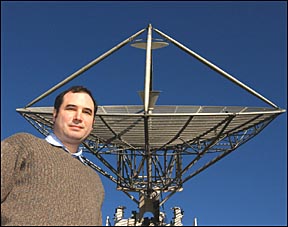|
|
|
|
|
December 13, 2002Moon may hold secrets of origins of life on Earth
As any agent will tell you, there are three basic principles in real estate: location, location, location. With that in mind, Guillermo Gonzalez, an assistant professor of physics and astronomy, would like to grab hold of some property on the moon and begin prospecting, because he believes there are some real treasures up there. It isn't gold Gonzalez is looking for. Nor is it diamonds. Gonzalez is looking for pieces of Earth on the moon, valuable pieces of Earth that could hold clues to its past and to the origins of life. Now he wants to go there to prove it. "Terran (from Earth) meteorites on the moon may provide a substantive geological record for ancient Earth, corresponding to or predating the period of the earliest evidence of life," Gonzalez said. "There are very few places you can go on this planet that preserve the clues to the origin of life because of Earth's geologic activity," Gonzalez said. Rain, wind, tides, plate tectonics and other natural forces have largely eroded many clues Earth may have held. Clues on the moon That fact got Gonzalez and his collaborators -- John Armstrong and Llyd Wells of the astrobiology program at the University of Washington, Seattle -- thinking that some clues may exist elsewhere. They chose the moon because of its location. When the planets formed some 3.8 billion years ago, the solar system was a much wilder place than it is today. The early planets were continually bombarded by asteroids and meteorites. Some of these impacts were so great and so devastating that they'd jar relatively large pieces of Earth and throw them up in the air with enough force to escape its atmosphere and orbit. The moon, much closer to Earth than it is today, was in a prime location to sweep up some of the debris. It also likely gained debris from the other inner solar system planets Mercury, Venus and Mars. "The moon is the perfect collector of debris," Gonzalez said. "It is roughly in the middle (of the inner planets) so it collected debris ejected from the inner planets and it preserves them. The moon has no atmosphere. No hydrological cycles. So whatever gets there, gets preserved." This, Gonzalez said, makes the moon Earth's dusty old attic, a sort of deep-freeze repository for relics of the terrestrial dawn. Gonzalez and his colleagues recently published a paper in Icarus, an international journal of solar system science, in which they calculated the concentration of Terran meteorites that could be on the moon. The moon could contain as much as 20 tons of Terran meteorites in the top one-half inch of a typical lunar area of about 40 square miles, Gonzalez said. These materials could contain geochemical and biological information such as isotopic signatures, organic carbon, biologically derived molecules and minerals and maybe even microbial fossils, he added. Help from roving robots To test the theory, Gonzalez first would like to go through the 800 or so pounds of lunar rock and dust that were brought back during the Apollo missions of the 1960s and 70s to see if they hold any Terran material. He estimates that as much as 3 grams of Terran material could be present in these samples. If these samples do contain Terran material, it could be enticing enough to make the case to return to the moon -- this time to search for ancient dust particles, or a small rock or two, that came from Earth long before the time of humans, or even dinosaurs. Gonzalez said recovering these materials would require roving robots on the lunar surface and an intelligent way of determining exactly where to look. He prefers looking in and near smallish craters and the rilles -- long, sharp lines or faults. These areas could expose what has been hidden just beneath the lunar surface, buried just deep enough so the samples wouldn't have been degraded by the constant rain of micrometeorites that "sandblasts" the rocks on the lunar surface. Spectral detection methods could be developed that would lead to the most promising areas to prospect on the moon, Gonzalez said. He suggests looking for minerals that require water to form, an attribute that would stick out on the dry, dusty lunar surface. Life in the universe Gonzalez's primary research emphasis is on "extrasolar planets" and developing spectral methods for locating stars that are most likely to have planets orbiting them. "I'm interested in questions about life in the universe," he said. The research with the moon has several life-type components. Could life have been transferred from planet to planet during the early solar system? Could Earth have been sterilized by one really huge impact and then "re-seeded" with life as fragments fell back to the planet? In addition to his work with extrasolar planets, Gonzalez has done research on galactic habitable zones, areas in the universe that are conducive to life. All of his work is fueled by his passion for astronomy, which he fell in love with as a child "because it's a beautiful science." |
|
Ames, Iowa 50011, (515) 294-4111 Published by: University Relations, online@iastate.edu Copyright © 1995-2001, Iowa State University. All rights reserved. |
